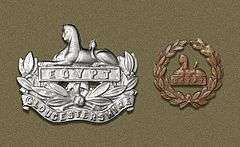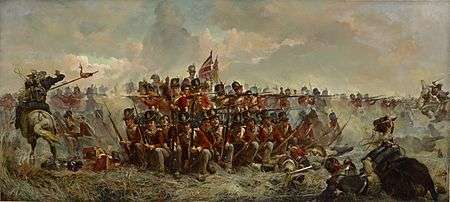Gloucestershire Regiment
| Gloucestershire Regiment | |
|---|---|
|
Cap badge (left) and back badge (right) of the Gloucestershire Regiment | |
| Active | 1881–1994 |
| Country |
|
| Branch |
|
| Type | Infantry |
| Role | Line infantry |
| Garrison/HQ | Horfield Barracks, Bristol |
| Nickname(s) | The Glorious Glosters, Slashers |
| Motto(s) | By our deeds we are known |
| March | The Kinnegad Slashers |
| Anniversaries | Back Badge Day (21 Mar) |
| Decorations |
|
The Gloucestershire Regiment was a line infantry regiment of the British Army. Nicknamed "The Glorious Glosters", the regiment carried more battle honours on their regimental colours than any other British Army line regiment. The Gloucestershire Regiment existed from 1881 until 1994 when it was amalgamated with the Duke of Edinburgh's Royal Regiment (Berkshire and Wiltshire) to form the Royal Gloucestershire, Berkshire and Wiltshire Regiment which was merged with the Devonshire and Dorset Regiment, The Light Infantry and the Royal Green Jackets to create a new large regiment, The Rifles.
Soldiers of the Gloucestershire Regiment, and subsequently the Royal Gloucestershire, Berkshire and Wiltshire Regiment from 1994 onwards, wore a cap badge on both the front and the rear of their headdress, a tradition maintained by soldiers in The Rifles when in service dress. The back badge is unique in the British Army and was adopted by the 28th (North Gloucestershire) Regiment of Foot to commemorate their actions at the Battle of Alexandria in 1801.
Origins
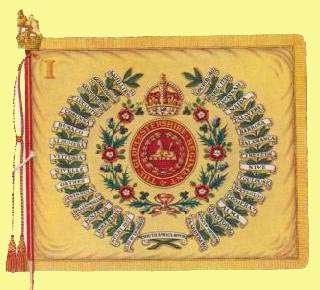
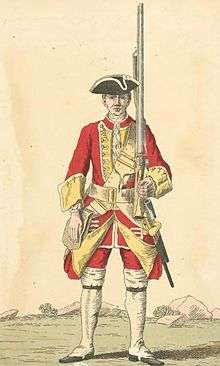
The Gloucestershire Regiment traced its roots to Colonel Gibson's Regiment of Foot which was raised in 1694 in Portsmouth[1] and first saw action in 1705 during the War of the Spanish Succession.[2] Having been commanded by (and therefore named after) a succession of colonels, the regiment was renamed in 1742 as the 28th Regiment of Foot and fought under this name during the War of the Austrian Succession.[3][4] Another predecessor, the 61st Regiment of Foot, was formed in 1758 when the British Army was expanded during the Seven Years' War. The 61st gained its first battle honour a year later during the invasion of Guadeloupe,[5][6] the same year that General Wolfe placed himself at the head of the 28th on the Plains of Abraham just prior to the capture of Quebec.[7]
In 1782 the British Army began linking foot regiments with counties for the purposes of recruitment. For the first time the county of Gloucestershire was associated with both the 28th and the 61st, which became known as the 28th (North Gloucestershire) Regiment of Foot and the 61st (South Gloucestershire) Regiment of Foot.[8] Both regiments began to recruit from the county, and it was in Gloucester in December 1782 that the 61st was presented with new Colours to replace those lost during the Franco-Spanish invasion of Minorca earlier that year.[9]
In March 1801 the 28th formed part of the British expeditionary force that landed at Aboukir Bay in Egypt to oppose Napoleon's Army of the East. On 21 March, during the Battle of Alexandria, French cavalry broke through the British lines, formed up behind the 28th, and began to charge. Still heavily engaged to their front, the order was given "Rear Rank, 28th! Right About Face", and standing thus in two ranks, back to back, the regiment successfully defended itself. For this action the 28th was accorded the unique privilege of wearing the regimental number both on the front and the back of its head-dress.[10] The 61st also deployed to Egypt and, although arriving too late to play an active part, was, like the 28th, awarded the battle honour 'Egypt' and the right to display the Sphinx on its Colours.[11]
During the 19th century relatively uneventful postings at home and abroad were punctuated with periods of active service. Both the 28th and the 61st fought against Napoleon in Spain and Portugal during the Peninsular War.[12] The 28th also participated in the final defeat of Napoleon, being commended by the Duke of Wellington for gallantry in the Battle of Quatre Bras, and seeing action again in the Battle of Waterloo.[13] In the mid-19th century both regiments were deployed to India, with the 61st seeing active service during the Second Anglo-Sikh War and the Indian Mutiny, resulting in the addition of 'Chillianwallah', 'Goojerat', 'Punjaub', and 'Delhi 1857' to the list of 61st battle honours that the Gloucestershire Regiment would soon inherit. The 28th, whose time in India was shorter and less eventful, was meanwhile deployed to the Crimea, adding 'Alma', 'Inkerman', and 'Sevastopol' to its legacy.[14]
Another thread that would be woven into the story of the Gloucestershire Regiment concerns the civilian administered auxiliary forces that supported the army in times of need. In the mid-18th century county militias were raised for home defence and as a pool of reserves for the regular army. By 1760 Gloucestershire had raised two battalions of militia, and in 1763 these were organised as the South Gloucestershire Militia based at Gloucester and the North Gloucestershire Militia at Cirencester.[15] In 1795 both militias were granted the 'Royal' prefix.[16] In 1859 the raising of county-based volunteer rifle corps was authorised, leading to the formation of the 1st (City of Bristol) Gloucestershire Rifle Volunteers and the 2nd Gloucestershire Rifle Volunteers.[17]
Formation of the Gloucestershire Regiment
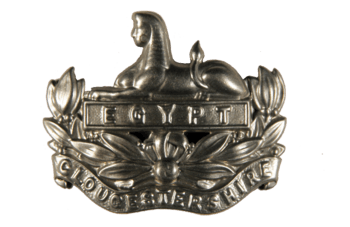
In 1872 the Cardwell Reforms began the process of organising the British Army along county lines based on two-battalion line infantry regiments, a process that was completed by the Childers Reforms nine years later. As a result, in 1881 the 28th and the 61st regiments were amalgamated to form the Gloucestershire Regiment, headquartered at Horfield Barracks in Bristol.[18][19] The reforms also added the county's auxiliary forces to the establishment, and at its formation the regiment thus comprised two regular and four auxiliary battalions...
- 1st Battalion – formerly the 28th (North Gloucestershire) Regiment of Foot
- 2nd Battalion – formerly the 61st (South Gloucestershire) Regiment of Foot
- 3rd (Militia) Battalion – formerly the Royal South Gloucestershire Militia
- 4th (Militia) Battalion – formerly the Royal North Gloucestershire Militia
- 1st (City of Bristol) Volunteer Battalion – formerly the 1st (City of Bristol) Gloucestershire Rifle Volunteers
- 2nd Volunteer Battalion – formerly the 2nd Gloucestershire Rifle Volunteers[20]
Despite the reforms, over three centuries of tradition that the two former regiments had between them amassed did not simply disappear into history. The Gloucestershire Regiment inherited from the 28th the privilege of wearing the back badge. It was a privilege that the 2nd Battalion did not want, but it was made palatable to the former 61st by replacing the number 28 with the Sphinx, a battle honour awarded to both predecessor regiments.[20]
Although both battalions were forced to give up their individual facing colours on their uniforms – yellow for the 28th and buff for the 61st – when the government imposed a standard white across all English and Welsh regiments, the Gloucestershire Regiment never accepted this change when it was applied to the Regimental Colour; both battalions retained their former Regimental Colours until 1929, when a compromise primrose yellow was finally chosen and a new Regimental Colour subsequently issued.[20][21]
The 1st Battalion celebrated the bicentenary of the regiment at Malta in 1894. The 2nd Battalion would hold special games followed by a dinner and a ball on the anniversary of the 61st Regiment's victory at Chillianwallah when overseas or on the anniversary of that regiment's victory at Salamanca when at home. The 1st Battalion, on the other hand, would celebrate the anniversary of the Battle of Alexandria. The two battalions continued to refer to themselves by their former regimental numbers right up until they were merged in 1948, when the Gloucestershire Regiment became a single-battalion regiment.[20][22]
Second Boer War
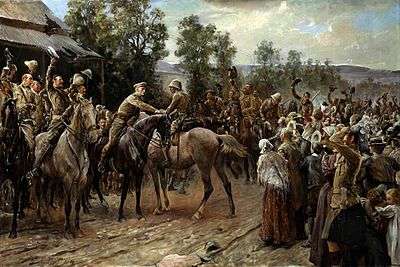
The Gloucestershire Regiment began life quietly, the two battalions alternating between postings at home and overseas, for the most part in India, but its baptism of fire came in 1899 during the Second Boer War. Deployed to Ladysmith, the 1st Battalion was part of a column sent out on 24 October to cover the withdrawal of a brigade after the Battle of Talana Hill. When the column came under fire near Rietfontein, the battalion was detached and ordered forward, but the order was ambiguous and the battalion advanced too far. The troops were caught in the open for several hours before they were able to extricate themselves at the cost of five men killed, including the battalion commander, and 58 wounded.[23]
Five days later some 450 men of the 1st Battalion were part of a small force tasked with seizing Nicholson's Nek, a pass some six miles (10km) north of Ladysmith, during the Battle of Ladysmith. Intending to be in position before the main battle started, the troops moved out on the night of 29 October, but left too late to reach their objective before daybreak. As they took up an alternative position on the nearby Tchrengula Hill the pack-mules bolted, taking most of the heavy weaponry and ammunition with them. Alerted to the presence of the enemy, the Boers quickly surrounded the position, and although the British held out for several hours they were forced to surrender at 12:30. The 1st Battalion lost 38 killed and 115 wounded, with the survivors being held as prisoners of war (POWs) in Pretoria.[24][25][26][27]
While the remainder of 1st Battalion helped in the defence of Ladysmith (the city was eventually relieved on 1 March) the 2nd Battalion deployed to South Africa, arriving in January 1900. The battalion played an active part in the Battle of Paardeberg, a nine-day battle which ended 27 February with the capture of the Boer general Piet Cronjé and his force of some 4000 men. The 2nd Battalion saw action again on 10 March in the Battle of Driefontein, and on 15 March entered the Boer city of Bloemfontein, where it was to remain on garrison duties until 1904. The 1st Battalion, re-united when its POWs were liberated after the capture of Pretoria on 5 July, was posted in August 1900 to Ceylon, where it remained until 1903 guarding Boer prisoners of war.[25][28]
Some of the regiment's auxiliary battalions, which in 1900 were increased in number with the formation of the 3rd Volunteer Battalion,[29] also played a role in the war. On 16 March 1900 a volunteer company of 124 officers and men from the 1st and 2nd volunteer battalions landed at Cape Town. They served for a year alongside 2nd Battalion, and were replaced by a second volunteer company in April 1901. The 4th (Militia) Battalion, meanwhile, guarded Boer prisoners held on St. Helena.[30] By the war's end the regiment had lost 2 officers and 94 other ranks killed, and 13 officers and 201 men wounded, with a further 250 deaths caused by sickness. The regiment added 4 new battle honours to its Colours: 'Defence of Ladysmith'; 'Relief of Kimberley'; 'Paardeberg'; and 'South Africa, 1899-1902'; the last of which was also awarded to the 1st and 2nd volunteer battalions.[31]
First World War

Following the Territorial and Reserve Forces Act 1907 – part of the Haldane Reforms which restructured the British Army and converted the militia and volunteer battalions into the Special Reserve and the Territorial Force – the 4th (Militia) Battalion was disbanded, and at the outbreak of the First World War in 1914 the Gloucestershire Regiment comprised...
- 1st Battalion – assigned to the 3rd Infantry Brigade, 1st Infantry Division, British Expeditionary Force
- 2nd Battalion – deployed to Tianjin, China
- 3rd (Special Reserve) Battalion – formerly 3rd (Militia) Battalion
- 4th (City of Bristol) Battalion, Territorial Force – formerly 1st (City of Bristol) Volunteer Battalion
- 5th Battalion, Territorial Force – formerly 2nd Volunteer Battalion
- 6th Battalion, Territorial Force – formerly 3rd Volunteer Battalion[32]
During the course of the war the regiment raised an additional 18 battalions. Each of the Territorial Force battalions volunteered for service overseas and raised a second battalion, the six battalions being numbered 1/4th, 2/4th, 1/5th, 2/5th, 1/6th, and 2/6th.[33][lower-alpha 1] The Territorials also raised a 3rd battalion each in 1915 as home-based reserves, though in 1916 these were merged to form the 4th Reserve Battalion.[36] Another home-based territorial battalion, the 17th, was raised in 1917. Additionally, as volunteers answered Kitchener's call to arms, between 1914 and 1916 ten New Army battalions, the 7th to the 16th, were added to the regiment's establishment. Finally, the 18th battalion was raised in 1918 from a cadre of the 5th Battalion, the Ox & Bucks Light Infantry.[33][37] In total, 16 battalions of the Gloucestershire Regiment saw active service during the war; in France and Flanders, Italy, Gallipoli, Egypt, Mesopotamia, Persia, and Macedonia.[38][lower-alpha 2]
Regular Army
The 1st Battalion landed at Le Havre in August 1914 as part of 3rd Brigade in the 1st Division and saw action on the Western Front.[37] The 2nd Battalion landed at Le Havre in December 1914 and saw action on the Western Front as part of the 81st Brigade in the 27th Division; the battalion moved to Salonica in late November 1915 and saw action on the Macedonian Front before transferring to the 82nd Brigade in same Division in November 1916.[37]
Territorial Force

The 1/4th (City of Bristol) Battalion landed at Boulogne in March 1915 and saw action on the Western Front as part of the 144th Brigade in the 48th (South Midland) Division.[37] The 1/5th Battalion landed at Boulogne in March 1915 and also saw action on the Western Front as part of the 145th Brigade in the 48th (South Midland) Division.[37] The 1/6th Battalion landed at Boulogne in March 1915 and saw action on the Western Front as part of the 144th Brigade in the 48th (South Midland) Division.[37] The 2/4th (City of Bristol) Battalion landed in France in May 1916 and saw action on the Western Front as part of the 183rd Brigade in the 61st (2nd South Midland) Division.[37] The 2/5th Battalion landed in France in May 1916 and saw action on the Western Front as part of the 184th Brigade in the 61st (2nd South Midland) Division.[37] The 2/6th Battalion landed in France in May 1916 and saw action on the Western Front as part of the 183rd Brigade in the 61st (2nd South Midland) Division.[37]
New Armies
The 7th (Service) Battalion landed at Gallipoli in June 1915 as part of the 39th Brigade in the 13th (Western) Division and, having been evacuated from Gallipoli in December 1915, was deployed to Egypt in January 1916.[37] The 8th (Service) Battalion landed in France in July 1915 as part of the 57th Brigade in the 19th (Western) Division and saw action on the Western Front.[37] The 9th (Service) Battalion landed in France in September 1915 as part of the 78th Brigade in the 26th Division before moving to Salonika in November 1915 and returning to France in July 1918.[37] The 10th (Service) Battalion landed in France in August 1915 as part of the 1st Brigade in the 1st Division.[37] The 12th (Service) Battalion (Bristol) landed in France in November 1915 as part of the 95th Brigade in the 5th Division.[37] The 13th (Service) Battalion (Forest of Dean) (Pioneers) landed in France in March 1916 as Divisional Pioneers to the 39th Division.[37] The 14th (Service) Battalion (West of England) landed at Le Havre in January 1916 as part of the 105th Brigade in 35th Division.[37] The 18th (Service) Battalion landed in France in August 1918 as part of the 49th Brigade in the 16th Division.[37]
Western Front
The regiment suffered its first casualties of the war on 26 August during the retreat from Mons, when 1st Battalion fought a rearguard action in the vicinity of Landrecies, 25 miles (40 km) southwest of Mons, losing 5 killed and 30 wounded before retiring with the rest of the 1st Division. By the time the BEF moved to Ypres in mid-October, total casualties to the battalion in the fighting along the river Aisne had risen to 150 officers and men.[42]
First Battle of Ypres
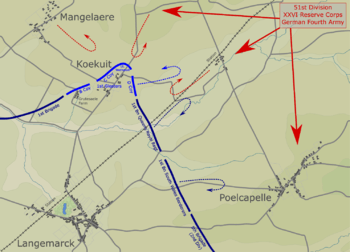
On 21 October, during the Battle of Langemarck, the opening engagement in the First Battle of Ypres, 1st Battalion occupied a salient around the village of Langemarck, nearly 5 miles (8.0 km) north of Ypres. Elements of C Company commanded by Lieutenant Wetherall, defending the tip of the salient at the hamlet of Koekuit, were particularly hard pressed, beating back repeated attacks until ordered to withdraw after dark. For his stubborn defence Wetherall was awarded the Military Cross (MC), one of the first to be awarded in the war.[43][44][45]
Two days later three platoons led by Captain Rising conducted a "...stout defence..." against a "...determined attack by the enemy..." on the northern outskirts of Langemarck. Their situation had become critical when the 1st Battalion Coldstream Guards was forced back, exposing the Glosters' left flank. Two of the three platoon leaders were killed, and the third wounded, and with 51 casualties amongst the other ranks, Rising's group came close to being overwhelmed.[46][47] For their actions Captain Rising was awarded the Distinguished Service Order (DSO),[48] Lieutenant Baxter (4 Platoon commander) was awarded the MC,[45] and four men were awarded the Distinguished Conduct Medal (DCM).[49]
On 29 October a large German force emerged from the early morning mist and practically annihilated the Guards battalions in the front-line near Gheluvelt, nearly 5 miles (8.0 km) east of Ypres. A counter-attack by 1st Battalion broke down into a series of disconnected company actions in which D Company advanced to within 300 yards (270 m) of the original front line, where they helped rally the remnants of the Guards but found themselves otherwise alone, facing enemy both to the north and east. The battalion lost 7 officers and 160 other ranks before the remainder of 3rd Brigade came up in support, allowing the survivors to retire.[50]
As the battle raged on around Ypres the Glosters were repeatedly called upon to participate in costly counter-attacks: on 31 October and 2 November around Gheluvelt; on 6 November towards Zwarteleen some 2 miles (3.2 km) southeast of Ypres; and on 11 November in the Battle of Nonne Bosschen. Casualties had at one stage reduced the battalion to 200 – 300 all ranks, around a quarter of its original strength. Other units fared little better, with 3rd Brigade having been reduced to little more than battalion strength. By mid-November the German attempt to capture Ypres exhausted itself, and 1st Battalion was taken out of the line to be rested and brought back up to strength. The Glosters had a month previously marched towards Langemarck with 25 officers and 970 other ranks. Of that number, just 2 officers and not more than 100 men had survived the First Battle of Ypres.[51]
Second Battle of Ypres
"I can go on taking the damned hill as often as you want, but I cannot hold it"
Captain Fane, B Company, 2nd Battalion[52]
The 2nd Battalion arrived in France in December 1914 as part of 81st Brigade, 27th Division, and on the eve of the Second Battle of Ypres, its first significant taste of combat, the battalion's strength was 22 officers and 789 men.[53][54] On 9 May 1915, during the Battle of Frezenberg Ridge – the only engagement of the four that comprised the Second Battle of Ypres to involve the regiment – the enemy succeeded in occupying part of the forward trench line held by 2nd Battalion. Some 30 men of B Company were cut off, and two failed attempts to retake the trenches could not rescue them. The survivors eventually managed the perilous journey back to the main line after dark, on a day which cost the battalion 5 officers (including the battalion commander) and 140 men. Company B was in action again two days later when it twice took at bayonet point a hill that overlooked the British trenches, both times being forced back by heavy artillery fire. The Battle of Frezenberg Ridge drew to a close on 13 May, and 2nd Battalion was taken out of the line when 81st Brigade was relieved. On 20 May they were inspected by the BEF commander, Field Marshall Sir John French, who told them "Your Colours have many famous names emblazoned on them, but none will be more famous or more well deserved than that of the Second Battle of Ypres".[55][56]
Battle of Aubers Ridge
If 9 May 1915 was a severe test for 2nd Battalion, the day went no better for 1st Battalion at Aubers Ridge. In the initial assault the men of 2nd Battalion Royal Munster Fusiliers and 2nd Battalion Welch Regiment were cut down practically as they left their trenches. A poorly coordinated follow-up attack by 1st Glosters and 1st Battalion South Wales Borderers fared even worse, serving only to add to the dead and wounded lying in no-man's land before being recalled. At 16:00, following a barrage as ineffective in softening up the German defences as the first two, the Glosters and Borderers launched a third attack. The enemy did not even take shelter, but lined their parapets to shoot down the British in an attack that reached no further than the enemy wire. 1st Battalion sustained 264 casualties this day - 11 officers and 253 other ranks. The heaviest losses were suffered by D Company which, in the final attack, lost all its officers, most of its NCOs, and about 90 men.[57][58]
Battle of Loos

In August 1915, 10th Battalion Gloucestershire Regiment and 8th Battalion Royal Berkshire Regiment replaced the two Guards battalions in 1st Brigade, and on 25 September these New Army battalions led the brigade's assault in the Battle of Loos. They took heavy casualties as they crossed the 400 yards (370 m) of no-man's land, but succeeded in taking their objectives, earning the praise of Field Marshal Sir John French. A letter home from an unnamed Lance-Corporal of the 10th mentions the gallantry displayed that day, and hints at the price paid:[59]
My word, as soon as the order was given the Gloucesters were out and over the parapet and soon doing great havoc among the Germans. About 400 yards separated us from the German first line; and I am sorry to say we lost a lot of gallant men getting there...
The battalion was practically destroyed, suffering 459 casualties.[60][61]
On 8 October, in trenches around a chalk pit in the southeast corner of the salient created by the British offensive, 1st Battalion took the brunt of an enemy counter-attack that was estimated at six battalions. With support from the artillery of 15th Division the attack was quickly broken up. The battalion lost about 130 men this day, but "...had a good fight; all ranks were overjoyed when the time came to meet the attackers with the bullet, thus to get their own back, not only for the shelling that they had endured earlier in the day, but also for the never-forgotten 9th of May".[62] The Battle of Loos ended on 13 October, and in total accounted for 324 casualties of all ranks in 1st Battalion.[63]
Battle of Albert
8th Battalion had arrived in France in July 1915, part of 57th Brigade, 19th (Western) Division, and until April 1916 had been in and out of the line, engaged in trench warfare but not in any major battle.[64] The battalion was the first of the Glosters to see action in the Somme offensive when, on 3 July during the Battle of Albert, 19th Division took over from the badly mauled 34th Division. When the commanders of the other three 57th Brigade battalions became casualties during an attack on La Boisselle the 8th Glosters' commanding officer, Lieutenant-Colonel Adrian Carton de Wiart, assumed control of their commands. The village was finally captured on 4 July, and 8th Battalion was relieved the next day, having suffered 6 officers killed, 14 wounded, and 282 other ranks killed, wounded, or missing. For his actions in averting a serious reverse at La Boisselle, Lieutenant-Colonel de Wiart, attached to 8th Battalion from the 4th Dragoon Guards (Royal Irish), was awarded the Victoria Cross (VC), which he credited to the 8th, "for every man in the Battalion has done as much as I have".[65][66][67][68]
Battle of Bazentin
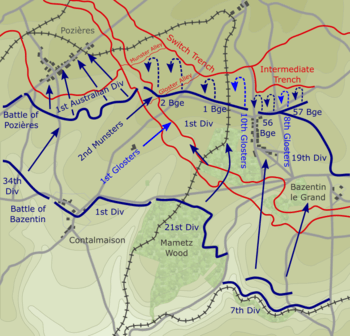
"There is some lead in me which ought not to be there"
Lieutenant A.R. Smith, 1/6th Battalion
1st Battalion entered the Somme offensive on the night of 16 July during the Battle of Bazentin. Following a push by 21st Division into Bazentin le Petit Wood on 14 July, 3rd Brigade advanced from Contalmaison in an intricate night attack which occupied the German front-line and support trenches northwest of the wood, and strong-posts were established in the communications trenches (one of the latter then being named Gloster Alley), for the loss to the battalion of three killed and 25 wounded.[69][70]
As 1st Battalion consolidated its position, the regiment's three front-line territorial battalions were moving into the line 4 miles (6.4 km) to the west. First into action at noon on 16 July was 1/4th Battalion, which for the next two days fought alongside 1/7th Battalion Worcestershire Regiment to capture the German trenches west and northwest of Ovillers, at a cost of 275 men.[71][72]
Having consolidated their positions in the former German trenches north of the village, the territorials made local attacks against strongpoints to the north and northeast. The intention was to gain ground towards Pozières Ridge in anticipation of the attack on Pozières itself. These actions were costly affairs; in just one example on 21 July 1/6th Battalion lost 3 officers and 101 other ranks as they battled to push the front line northwards.[73][74] In a letter to his mother, now held by the Regimental Museum, Captain L. Cameron Nott, serving with 1/6th Battalion, gives a mournful roll-call of some of the many officers who fell during this period, amongst them Lieutenant Arthur Roughton Smith, wounded on 21 July:
Smith, poor fellow, has died of wounds. I passed him on his way down – though hit in seven places, his courage was wonderful. I asked him how he felt & he said with a smile "There is some lead in me which ought not to be there & I am afraid I have done in your tunic. I am awfully sorry".[75][76]
Before the Battle of Bazentin began, 18th Division had been ordered to capture Trônes Wood some 2.5 miles (4.0 km) southeast of Bazentin le Petit Wood, and this was accomplished on the morning of 14 July.[77] On 18 July the bantam 35th Division relieved 18th Division,[78] and the following day the Glosters' 14th Battalion, which arrived in France as part of 105th Brigade of 35th Division in January 1916,[79] suffered 107 casualties in a day in the line at the northern end of Trônes Wood.[80]
Battle of Fromelles
The three second-line territorial battalions of the Gloucestershire Regiment – 2/4th, 2/5th, and 2/6th – were deployed to France in May 1916 as part of the 61st (2nd South Midland) Division. On 19 July the 2/4th and 2/6th were the assault battalions of 183rd Bridage, in the centre of 61st Division's front during the Battle of Fromelles. The attack, which also involved the equally inexperienced Australian 5th Division, was a diversionary action designed to draw German troops away from the main effort on the Somme. J.D.Wyatt, a company commander in the 2/4th, witnessed the moment the Glosters commenced their assault:
Attacking Companies had started to go over the parapet when the bombardment lifted and were met immediately by a very heavy machine gun fire. The leading platoons were practically wiped out at once and no one could get any further. The other Regiments on our flanks got it worse if anything.[81]
The territorials were assaulting not far from where 1st Battalion had suffered so badly in the Battle of Aubers Ridge the previous year, and the same inadequate artillery preparation resulted in the same futile losses against strong defences.[82] Casualties to 2/4th Battalion numbered 7 of its 20 officers and 152 of the 550 other ranks that formed up at the start of the battle, while of the 20 officers and 600 men of the 2/6th, 13 officers and 164 men were lost.[83]
Battle of Pozières
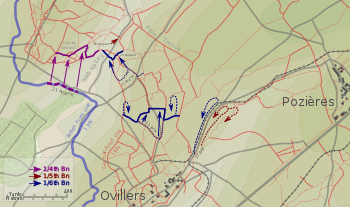
When the 1st Australian Division started its assault on Pozières at 00:30 on 23 July the Glosters of 1/5th and 1/6th Battalions made supporting attacks against the German trenches about 1 mile (1.6 km) to the west. At the same time, about 1.5 miles (2.4 km) to the east of the village, 10th Battalion was part of 1st Brigade's attack on the German trenches known as the Switch Line. Some 750 yards (690 m) to the right of the 10th, 8th Battalion advanced as part of the 57th Brigade attack on the Intermediate Trench which ran south of the Switch Line. Although the Australian assault succeeded in capturing Pozières, the British attacks were repulsed with heavy casualties. 1/5th Battalion lost 8 officers and 148 other ranks, while 8th Battalion lost 14 officers, including Lieutenant-Colonel de Wiart with a gunshot wound to the neck, and 186 other ranks.[84][85][86]
8th Battalion was back in action on 30 July in another attack on the Intermediate Trench. Its advance was held up by machine-gun and sniper fire which eventually forced it back to the start line with the loss of 14 officers and 160 other ranks. For the second time in a week the battalion lost its commanding officer when Major Lord A.G. Thynne, who had taken over command on 24 July, was wounded as he urged his men on.[87] As the Australians pushed on from Pozières to attack Mouquet Farm, 10th Battalion made two further attempts against the Intermediate Trench, on 17 and 19 August, but both attacks failed.[88]
Meanwhile, after a three-week rest the territorials returned to the line on the Australian left flank. They continued to press northwards, initially without success, but on 21 August an attack by 1/4th Battalion succeeded in occupying the first two lines of the Leipzig Redoubt about 1.5 miles (2.4 km) west of the farm.[89] On the 1/4th's right, 1/6th Battalion was engaged in two days of fierce fighting, at one stage having their own captured store of bombs used against them, before finally subduing the enemy and securing the flank on the morning of 23 July.[90] The territorial's final action in the Battle of Pozières was on 27 August, when 1/5th Battalion made a successful assault near Pole Trench in Nab valley, to the east of the Leipzig Redoubt, taking some 50 prisoners and inflicting an estimated 200 casualties on the enemy for the loss of 6 officers and 98 other ranks.[91][92]
High Wood
1st Battalion played no part in the Battle of Pozières itself, though at the end of August it spent a week in the line near High Wood, nearly 2.5 miles (4.0 km) east of Pozières, during which time it endured the most intense shelling it experienced in the whole war. After three days the trenches were practically obliterated, forcing the men into the shell holes in front of them, and by the time the battalion was relieved on 28 August it had lost 46 killed and 141 wounded.[93]
The battalion returned to the line in front of High Wood on 8 September and at 18:00, with 2nd Welch on their right and a battalion of 15th Division on their left, attacked into the wood. One platoon of A Company was practically wiped out before the company reached the German second line, and on its right fierce fighting severely weakened B Company before it was eventually able to join A Company. Companies C and D following in support took many casualties, and only a few of these men made it to the objective unwounded.[94]
As it consolidated its gains the battalion continued to take casualties, and heavy shelling also took a toll of the wounded making their way back to the rear lines. Lacking reinforcement, the survivors were ordered to withdraw, and by 22:00 they were back in their original trenches from which, at 03:00 on 9 September, they repulsed a German counter-attack.[95] Later that day 10th Battalion, attached to 3rd Brigade alongside 1st Battalion, suffered 122 casualties in a failed attack through the northwest corner of the wood.[96][97]
The attack on High Wood was the last significant action of 1st Battalion in the Somme offensive, and cost it 13 officers (amongst them the commanding officer Lieutenant-Colonel Pagan), of whom 5 were killed, and 206 other ranks, of whom 84 were killed, leaving the battalion with just 4 officers and 96 other ranks fit for duty.[98]
Battle of Guillemont
12th Battalion arrived in France in December 1915 when 95th Brigade was transferred to 5th Division,[99] and also experienced its first significant combat during the Somme offensive when, on 29 July, B and C Companies participated in an attack near Longueval, about 1 mile (1.6 km) southeast of High Wood. On 3 September, the first day of the Battle of Guillemont, the battalion was in action again in a 95th Brigade attack which succeeded in occupying the German second line from Wedge Wood to the southeastern edge of Guillemont, over 1 mile (1.6 km) southeast of Longueval. On the brigade's right flank, however, the attack against Falfemont Farm had stalled, and enfilading fire from enemy machine-guns there accounted for 328 casualties amongst the Glosters. The farm was eventually captured on 5 September, and on that day 12th Battalion pushed on to Leuze Wood, nearly 1 mile (1.6 km) east of Guillemont, completing an advance of 3,500 yards (3,200 m) by 95th Brigade during the battle.[100][101]
Fifth Gloucester Gazette
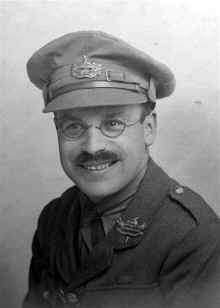
The Fifth Gloucester Gazette was "a chronicle, serious and humorous, of the Battalion while serving with the British Expeditionary Force", published from the front lines by the men of 1/5th Battalion. The first issue appeared 12 April 1915, foreshadowing more famous trench journals such as The Wipers Times, and ran for 25 issues, the last of which appeared in January 1919.[102][103][104] The gazette featured jokes, poetry, short stories, news, and satirical adverts, and in October 1916 The Times Literary Supplement hailed it as "the oldest and most literary of the British trench journals".[105]
The gazette was regarded so highly due in part to the efforts of famous war poet and founding contributor F. W. Harvey, who published 77 poems in it while serving with the 1/5th.[106][107] Five of Harvey's poems were included in the 1917 anthology of war poetry, The Muse in Arms which, alongside poems from Siegfried Sassoon, Robert Graves, and Rupert Brooke, also featured the poetry of two other Glosters; Lt. Cyril Winterbotham, who served in 1/5th Battalion, and edited the gazette until he was killed in action on 27 August 1916; and Harvey's pre-war friend Ivor Gurney, who served in 2/5th Battalion, and who achieved fame as both poet and composer.[108][109][110]
Second World War
Regular Army
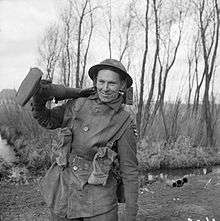
The 1st Battalion was serving in British India on the outbreak of the Second World War, having been there since 1932.[111] The battalion saw active service in the Burma Campaign against Imperial Japanese Army forces in early 1942 whilst serving with the 63rd Indian Infantry Brigade, 17th Indian Infantry Division in the early stages of the campaign. The battalion spent the rest of the war mainly on internal security duties in India.[112]
The 2nd Battalion, Gloucestershire Regiment was a Regular Army unit originally assigned to the 8th Infantry Brigade, 3rd Infantry Division and was sent to France in September 1939, shortly after the outbreak of war.[113] The division was commanded by Major-General Bernard Montgomery. In February 1940 the battalion was exchanged for the 4th Battalion, Royal Berkshire Regiment and joined the 145th Infantry Brigade attached to 48th (South Midland) Infantry Division and fought with them in the Battle of Dunkirk and were evacuated there after fierce fighting in Belgium and France. After returning to England, the battalion spent many years on home defence, anticipating a German invasion which never arrived. The battalion remained with 145th Brigade until late December. Later, in early 1944, the battalion was reassigned to the 56th Infantry Brigade (including 2nd South Wales Borderers and 2nd Essex Regiment). The brigade was involved in the D-Day landings on 6 June 1944 and fought through the entire Normandy Campaign attached to many different divisions until August 1944 when it officially joined the 49th (West Riding) Infantry Division and remained with it for the rest of the war. By the end of the war in Europe 2nd Glosters had suffered 718 officers and men killed, wounded or missing in action.[114]
Territorial Army
The 5th Battalion was a Territorial Army unit that served with the 2nd Battalion in the 48th Division and was also involved in the fighting around Dunkirk and were evacuated to England. In 1941, the battalion was transferred to the Reconnaissance Corps and redesignated the 48th Battalion, Reconnaissance Corps and acted as the divisional reconnaissance for the 48th (South Midland) Division. In November 1941 it was transferred to the 43rd (Wessex) Division and was again redesignated the 43rd Reconnaissance Regiment. The regiment served with the 43rd (Wessex) Division for the rest of the war in particular during the Normandy Campaign and Operation Market Garden.[115]
Before the war, the 6th Battalion, Glosters was converted into the 44th Royal Tank Regiment and was assigned to the 21st Army Tank Brigade.[116]
The 7th Battalion, Gloucestershire Regiment was raised in 1939 as a 2nd Line duplicate of the 5th Battalion when the Territorial Army was doubled in size as another large European conflict seemed almost inevitable. The battalion was assigned to the 183rd Infantry Brigade, 61st Infantry Division and served with the same brigade and division until July 1944 when it was transferred to the 213th Brigade, 47th Division and was converted into a reserve training battalion.[117]
Hostilities-only
The 8th (Home Defence) Battalion was raised in late 1939 from the National Defence Companies and, like most other home service units, consisted of a mixture of older veterans with previous military experience who were too old for active service and younger soldiers who were too young to be conscripted. These younger soldiers would later be transferred to help form the 70th (Young Soldiers) Battalion.[118]
The 10th Battalion was raised in 1940 due to the huge expansion of the Army and was assigned to the 212th Independent Infantry Brigade (Home).[119] The battalion was converted to armour in 1942 as 159th Regiment in the Royal Armoured Corps though retaining its Glosters cap badge on the black beret of the Royal Armoured Corps and, after being sent to India, joined the 255th Indian Armoured Brigade.[120] It re-converted to infantry as 10th Glosters the following year in India and joined the 72nd Infantry Brigade attached to the 36th Infantry Division.[121]
The 11th Battalion was raised in 1940, assigned to the 221st Independent Infantry Brigade (Home).[122] In February 1942 it was transferred to the Royal Regiment of Artillery and converted into the 118th Light Anti-Aircraft Regiment, Royal Artillery,[123] serving with the 49th (West Riding) Division from May to August. From August 1942 to June 1943 it served with Home Forces and was sent to British India.[124]
The 70th (Young Soldiers) Battalion was formed in 1940 from young soldiers around the ages of 18 and 19 who were, at the time, too young to be conscripted into the military as the age was 20. Like other similar units, the battalion remained in the United Kingdom throughout the war on internal security duties and was disbanded in late 1942, shortly before the British government lowered the age of recruitment to 18.[118]
Korean War
The regiment saw heavy fighting in the Korean War. After their actions at Gloster Hill during the Battle of the Imjin River in 1951, following which the regiment was awarded the United States Distinguished Unit Citation for its heroic last stand against overwhelming Chinese forces. This entitled the 1st Battalion of the regiment to place a blue streamer on the regimental colour and to wear a dark blue watered ribbon in a gold frame on the shoulder of the uniform.[125][126]
Modern history
The regiment amalgamated with the Duke of Edinburgh's Royal Regiment in 1994 to form the 1st Battalion, the Royal Gloucestershire, Berkshire and Wiltshire Regiment.[127]
Regimental museum
The regimental archives and memorabilia of the Glosters as well as their antecedents, the 28th and 61st Regiments of Foot are held by the Soldiers of Gloucestershire Museum, which is located within the Historic Docks in Gloucester and available on-line at Soldiers of Gloucestershire Museum.[128]
Battle honours
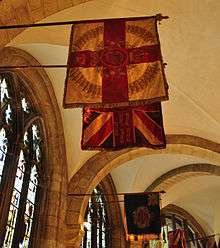
The regiment was awarded the following battle honours:[129]
- From 28th Regiment of Foot: Egypt, Corunna, Barrosa, Albuhera, Vittoria, Pyrenees, Nivelle, Nive, Orthes, Toulouse, Peninsula, Waterloo, Alma, Inkerman, Sevastopol
- From 61st Regiment of Foot: Egypt, Maida, Talavera, Salamanca, Pyrenees, Nivelle, Nive, Orthes, Toulouse, Peninsula, Chillianwallah, Goojerat, Punjaub, Delhi 1857
- Ramillies, Louisburg, Guadaloupe 1759, Quebec 1759, Martinique 1762, Havannah, St Lucia 1778, Busaco, Defence of Ladysmith, Relief of Kimberley, Paardeberg, South Africa 1899–1902
- The Great War (25 battalions): Mons, Retreat from Mons, Marne 1914, Aisne 1914 '18, Ypres 1914 '15 '17, Langemarck 1914 '17, Gheluvelt, Nonne Bosschen, Givenchy 1914, Gravenstafel, St Julien, Frezenberg, Bellewaarde, Aubers, Loos, Somme 1916 '18, Albert 1916, '18, Bazentin, Delville Wood, Pozières, Guillemont, Flers-Courcelette, Morval, Ancre Heights, Ancre 1916, Arras 1917 '18, Vimy 1917, Scarpe 1917, Messines 1917 '18, Pilckem, Menin Road, Polygon Wood, Broodseinde, Poelcappelle, Passchendaele, Cambrai 1917 '18, St Quentin, Bapaume 1918, Rosières, Avre, Lys, Estaires, Hazebrouck, Bailleul, Kemmel, Béthune, Drocourt-Quéant, Hindenburg Line, Épéhy, Canal du Nord, St Quentin Canal, Beaurevoir, Selle, Valenciennes, Sambre, France and Flanders 1914–18, Piave, Vittorio Veneto, Italy 1917–18, Struma, Doiran 1917, Macedonia 1915–18, Suvla, Sari Bair, Scimitar Hill, Gallipoli 1915–16, Egypt 1916, Tigris 1916, Kut al Amara 1917, Baghdad, Mesopotamia 1916–18, Persia 1918
- The Second World War: Defence of Escaut, St Omer-La-Bassée, Wormhoudt, Cassel, Villers Bocage, Mont Pincon, Falaise, Risle Crossing, Le Havre, Zetten, North-West Europe 1940 '44–45, Taukyan, Paungde, Monywa 1942, North Arakan, Mayu Tunnels, Pinwe, Shweli, Myitson, Burma 1942 '44–45
- Korean War: Hill 327, Imjin, Korea 1950–51
- 4th Battalion (Militia): St. Helena 1901, South Africa 1900–02
(Under an Army Order issued in October 1910 battle honours awarded to former militia battalions were to cease to be borne: special reserve battalions could continue to carry colours with the old honours "as a temporary measure" if they chose, but only until they were presented with replacement colours.)[130] - 4th, 5th Battalions: South Africa 1900–02
(Following the First World War it was decided that each infantry regiment, including the territorial battalions, should have a single roll of battle honours. Accordingly, the territorial battalions of the Gloucestershire Regiment adopted the honours of the regular battalions.)[131]
Victoria Crosses
The regiment was awarded the following Victoria Crosses:
- Daniel Burges : World War I, also a holder of the DSO and Croix de Guerre
- James Power Carne : Korean War for action during the Battle of the Imjin River, also awarded the DSO
- Manley Angell James : World War I, survived and also served in World War II, retiring as a Brigadier
- Philip Curtis : Korean War awarded posthumously for actions during the Battle of Imjin River. (Duke of Cornwall's Light Infantry attached to 1st Battalion)
- Francis George Miles : World War I
- Hardy Falconer Parsons : World War I
- Herbert Taylor Reade : Indian Mutiny
Footnotes
- ↑ The Territorial Force was originally designed to replace the regular army in home defence when the latter was sent overseas. The territorials were under no obligation themselves to serve overseas, but could volunteer to do so, and when at the beginning of the war they did, second-line battalions were formed from the men who declined, or were too young or too old, to go. These battalions suffered from a lack of priority in equipment, and trained men were often transferred to the first-line battalions as replacements. As manpower shortages loomed, the Military Service Act 1916 introduced conscription and obliged all men of the Territorial Force either to accept military service overseas with their battalion or to resign and be conscripted anyway.[34][35]
- ↑ At full establishment a standard British infantry battalion of the time numbered a little over 1000 men, organised into four companies lettered A – D. Each company was some 227 men strong and commanded by a Major or a Captain, with a Captain as second-in-command, and was further sub-divided into four platoons. Each platoon was some 53 men strong and commanded by a lieutenant or second-lieutenant.[39] Four battalions together formed a Brigade,[40] and a Division comprised three brigades.[41]
Notes
- ↑ Daniell p.3
- ↑ Daniell p.12
- ↑ Daniell p.18
- ↑ "Bragg's Regiment and the 28th Foot – Soldier of Gloucestershire". Soldiers of Gloucestershire Museum. Retrieved 5 July 2016.
- ↑ Daniell pp.23-25
- ↑ "The Creation of the 61st Regiment of Foot – Soldier of Gloucestershire". Soldiers of Gloucestershire Museum. Retrieved 5 July 2016.
- ↑ Daniell pp.34-39
- ↑ "North and South Gloucestershire – Soldier of Gloucestershire". Soldiers of Gloucestershire Museum. Retrieved 5 July 2016.
- ↑ Daniell p.54
- ↑ Daniell pp.69-75
- ↑ "The Battle of Alexandria – Soldier of Gloucestershire". Soldiers of Gloucestershire Museum. Retrieved 5 July 2016.
- ↑ Daniell ch.IX-X
- ↑ Daniell ch.XI
- ↑ Daniell ch.XIII-XIV
- ↑ Daniell p.26
- ↑ David Viner. "'A moth-eaten rag': Regimental Colours in Cirencester Parish Church" (PDF). Gloucestershire History. Retrieved 9 July 2016.
- ↑ Daniell pp.184-187
- ↑ The London Gazette: no. 24992. pp. 3300–3301. 1 July 1881.
- ↑ Daniell pp.186-187
- 1 2 3 4 "The Gloucestershire Regiment – Soldier of Gloucestershire". Soldiers of Gloucestershire Museum. Retrieved 7 July 2016.
- ↑ Daniell p.188
- ↑ Daniell p.189
- ↑ Daniell pp.190-191
- ↑ Daniell pp.191-194
- 1 2 "Gloucestershire Regiment". Anglo Boer War. Retrieved 9 July 2016.
- ↑ "Liverpool Regiment". Anglo Boer War. Retrieved 9 July 2016.
- ↑ "The Siege of Ladysmith – Soldier of Gloucestershire". Soldiers of Gloucestershire Museum. Retrieved 9 July 2016.
- ↑ Daniell pp.194-199
- ↑ Daniell p.199
- ↑ "Regulars and Volunteers in the Boer War – Soldier of Gloucestershire". Soldiers of Gloucestershire Museum. Retrieved 10 July 2016.
- ↑ Daniell pp.199-200
- ↑ Daniell pp.201-202
- 1 2 "Outbreak of First World War – Soldier of Gloucestershire". Soldiers of Gloucestershire Museum. Retrieved 12 July 2016.
- ↑ Beckett pp230-231
- ↑ "61st (2nd South Midland) Division - The Long, Long Trail". The Long, Long Trail. Retrieved 22 September 2016.
- ↑ Daniell p.423
- 1 2 3 4 5 6 7 8 9 10 11 12 13 14 15 16 17 "The Gloucestershire Regiment". The Long, Long Trail. Retrieved 29 December 2015.
- ↑ Daniell p.203
- ↑ "What was a battalion of infantry? - The Long, Long Trail". Retrieved 6 August 2016.
- ↑ "What was an Infantry Brigade? - The Long, Long Trail". Retrieved 6 August 2016.
- ↑ "What was a Division? - The Long, Long Trail". Retrieved 6 August 2016.
- ↑ Daniell pp204-205
- ↑ Daniell p205
- ↑ Wyrall pp64-68
- 1 2 "Supplement to the London Gazette, 18 February, 1915." (PDF). London Gazette. Retrieved 16 July 2016.
- ↑ Wyrall pp68-69
- ↑ Daniell p205
- ↑ "Supplement to the London Gazette, 9 November, 1914." (PDF). London Gazette. Retrieved 16 July 2016.
- ↑ Wyrall pp69-70 The DCM recipients were Sergeants Eddy and Knight, both of A Company, Private Crossman, also A Company, and Private Wilson, D Company.
- ↑ Wyrall pp70-75
- ↑ Wyrall pp77-88
- ↑ Wyrall p112
- ↑ Daniell p207
- ↑ Wyrall pp100-102
- ↑ Wyrall pp108-113
- ↑ Daniell pp207-208
- ↑ Wyrall pp117-118
- ↑ Daniell p208 Daniell gives the casualties as 11 officers and 275 other ranks
- ↑ Daniell p209
- ↑ "The Battle of Loos - The Long, Long Trail". The Long, Long Trail. Retrieved 4 September 2016.
- ↑ Wyrall p122. Wyrall states that the 10th Battalion lost all but some 60 men. A search using the Commonwealth War Graves Commission Find War Dead facility for deaths incurred by the 10th Battalion The Gloucestershire Regiment on 25 September 1915 yields 162 names.
- ↑ Daniell p211 Quoting Lieutenant-Colonel Pagan, the battalion commander
- ↑ Wyrall p126-127. 5 officers and 63 other ranks killed, and 5 officers and 251 other ranks wounded
- ↑ Wyrall, The Nineteenth Division, p23
- ↑ Gliddon
- ↑ 8th Battalion War Diary p115
- ↑ Daniell p223
- ↑ The London Gazette: (Supplement) no. 29740. p. 8869. 9 September 1916. Retrieved 5 September 2016.
- ↑ Daniell pp219-220
- ↑ McCarthy p51
- ↑ Wyrall pp155-158. The attack on Ovillers involved both the 48th and 25th Divisions
- ↑ Daniell pp221-222
- ↑ Wyrall pp159-160
- ↑ Daniell p222
- ↑ Wyrall pp160-161
- ↑ "The Gloucesters on the Somme – Soldier of Gloucestershire". Soldiers of Gloucestershire Museum. Retrieved 31 July 2016.
- ↑ McCarthy pp45-46
- ↑ McCarthy p52
- ↑ "The Gloucestershire Regiment". The Long, Long Trail. Retrieved 29 December 2015.
- ↑ Westlake p138
- ↑ Papers of Lt Col J D Wyatt, Imperial War Museum Department of Documents, 4160 Box 83/12/1
- ↑ Lee pp1, 121-122, 137-138, & 152. The other units involved fared even worse than the Glosters. The 61st Division suffered 1547 casualties, while the Australian 5th Division lost 5533 men, making the battle the bloodiest 24 hours in the history of the Australian army
- ↑ War Diaries and papers of the 61st Division. WO 95/3033 Headquarters Branches and Services: General Staff 1915 Sept. - 1917 May
- ↑ Wyrall pp160-163 & p165. Sources do not give details of 10th Battalion casualties, though a search using the Commonwealth War Graves Commission Find War Dead facility for deaths incurred by the 10th Battalion The Gloucestershire Regiment on 23 July 1916 yields 52 names. The 1/6th Battalion reported total casualties for the month of July, which combines losses suffered before and during the Battle of Pozières, as 8 officers killed and 11 wounded, plus 20 killed, 62 missing, and 296 wounded amongst the other ranks.
- ↑ Keech pp69-72 & 76-78
- ↑ 8th Battalion War Diary p117
- ↑ 8th Battalion War Diary pp117-118
- ↑ Westlake p137. Again the sources give no figures for casualties, though a search using the Commonwealth War Graves Commission Find War Dead facility for deaths incurred by the 10th Battalion The Gloucestershire Regiment 17-19 August 1916 yields 37 names.
- ↑ Wyrall pp167-172
- ↑ Wyrall pp169-170 & 172-173
- ↑ McCarthy p84
- ↑ Wyrall pp173-174. Amongst the fallen was the Fifth Gloster Gazette editor Lieutenant Cyril Winterbotham.
- ↑ Wyrall pp166-167
- ↑ Wyrall pp175-177
- ↑ Wyrall pp176-177
- ↑ Rawson p171
- ↑ Westlake p137
- ↑ Wyrall pp177-178
- ↑ Hussey & Inman p90
- ↑ Hussey & Inman pp120-123
- ↑ Westlake p137
- ↑ "Life and Times: How Gloucester soldiers created the first trench journal - Gloucestershire Live". The Gloucester Citizen. Retrieved 29 July 2016.
- ↑ Harvey, Foreword.
- ↑ "The Fifth Gloucester Gazette a chronicle, serious and humorous, of the Battalion while serving with the British Expeditionary Force". Imperial War Museum. Retrieved 30 July 2016.
- ↑ "Life and Times: How Gloucester soldiers created the first trench journal - Gloucestershire Live". The Gloucester Citizen. Retrieved 29 July 2016.
- ↑ Harvey, Foreword. In September 1916 Harvey's work was published as a collection in its own right, titled A Gloucestershire Lad at Home and Abroad, though by this time Harvey was already a month into his captivity, having been taken prisoner on 17 August. Harvey continued to write from the prison camps, and a second collection of his poetry, titled Gloucestershire Friends: Poems from a German Prison Camp, having been forwarded by his captors, was published in September 1917.
- ↑ Harvey, Biographical Note
- ↑ "The muse in arms, a collection of war poems, for the most part written in the field of action". John Murray. 1917. Retrieved 30 July 2016. A collection of Gurney's poems titled Severn & Somme was published in 1917
- ↑ "The Hindenburg Line & Third Ypres – Soldier of Gloucestershire". Soldiers of Gloucestershire Museum. Retrieved 30 July 2016.
- ↑ Thornicroft pp.14-16
- ↑ "1st Bn, The Gloucestershire Regiment: Service". Archived from the original on 3 January 2006. Retrieved 29 December 2015.
- ↑ Datasouth UK Ltd. "Soldiers of Gloucestershire military museum, online shop and genealogy search". Retrieved 29 December 2015.
- ↑ "2nd Bn, The Gloucestershire Regiment: Service". Archived from the original on 10 January 2006. Retrieved 29 December 2015.
- ↑ The Polar Bears - Monty's Left Flank: From Normandy to the relief of Holland with the 49th Division, Patrick Delaforce
- ↑ "1944 - Invasion & Liberation". Soldiers of Gloucestershire. Retrieved 29 December 2015.
- ↑ "44th Royal Tank Regiment [UK]". Archived from the original on 27 December 2005. Retrieved 29 December 2015.
- ↑ Joslen, p. 376
- 1 2 "The Officers of the 70th Young Soldiers Battalion, DLI, October 1941". Retrieved 28 December 2015.
- ↑ Joslen, p. 375.
- ↑ Forty p. 51
- ↑ Joslen p. 497.
- ↑ Joslen, p. 384.
- ↑ "Holland & Germany". Soliers of Gloucestershire. Retrieved 28 December 2015.
- ↑ "Private Papers of Major R O Garne". Imperial War Museum. Retrieved 28 December 2015.
- ↑ "Heroism of the Gloucesters". The Times. 9 May 1951. p. 6.
- ↑ "Return of the Gloucesters". The Times. 21 December 1951. p. 6.
- ↑ "The Royal Gloucestershire, Berkshire and Wiltshire Regiment". Retrieved 24 May 2014.
- ↑ "Soldiers of Gloucestershire Museum". the Ogilby Trust. Retrieved 29 December 2015.
- ↑ "Gloucestershire Regiment". Regiments.org. Archived from the original on March 3, 2007. Retrieved 29 December 2015.
- ↑ "Colours of the Special Reserve". The Times. 27 February 1911. p. 7.
- ↑ "Territorial Army. Pre-War Battle Honours On Colours.". The Times. 7 July 1924. p. 11.
References
- Beckett, Ian Frederick William (1991). The Amateur Military Tradition: 1558-1945. Manchester University Press. ISBN 0-7190-2912-0.
- Carew, Tim (1970). The Glorious Glosters: A short history of the Gloucestershire Regiment 1945–1970. Leo Cooper. ISBN 978-0-85052-024-8.
- Scott Daniel, David (1975). Cap of Honour. George G Harrap. ISBN 0-7509-4172-3.
- Edmonds, J. E.; Wynne, G. C. (1995) [1927]. Military Operations France and Belgium, 1915: Winter 1915: Battle of Neuve Chapelle: Battles of Ypres. History of the Great War Based on Official Documents by Direction of the Historical Section of the Committee of Imperial Defence. I (Imperial War Museum and Battery Press ed.). London: Macmillan. ISBN 0-89839-218-7.
- Edmonds, J. E. (1928). Military Operations France and Belgium, 1915: Battles of Aubers Ridge, Festubert, and Loos. History of the Great War Based on Official Documents By Direction of the Historical Section of the Committee of Imperial Defence. II (1st ed.). London: Macmillan. OCLC 58962526.
- Forty, George (1998). British Army Handbook 1939–1945. Stroud: Sutton Publishing. ISBN 0-7509-1403-3.
- Gliddon, Gerald (2012). VCs of the First World War: Somme 1916. The History Press. ISBN 978-0752463032.
- Harvey, F.W. (2014). The Lost Novel of FW Harvey: A War Romance. The History Press Ltd. ISBN 978-0750959711.
- Hussey, A. H.; Inman, D. S. (1921). "The Fifth Division in the Great War" (PDF). London: Nisbet. ISBN 1-84342-267-0. Retrieved 9 October 2016.
- Joslen, Lt-Col H.F. (1960). Orders of Battle, United Kingdom and Colonial Formations and Units in the Second World War, 1939–1945. I. Uckfield: Naval & Military. London: HM Stationery Office. ISBN 1843424746.
- Keech, Graham (1998). Pozieres: Somme (Battleground Europe). Pen & Sword Books. ISBN 978-0850525892.
- Lee, Roger (2015). Battle of Fromelles 1916. Big Sky Publishing. ISBN 978-0980658293.
- McCarthy, Chris (1998). The Somme: The Day by Day Account. The Caxton Publishing Group. ISBN 978-1860198731.
- Rawson, Andrew (2014). Somme Campaign. Pen & Sword Books. ISBN 978-1783030514.
- Thornicroft, Nick (2007). Gloucestershire and North Bristol Soldiers on the Somme. The History Press Ltd. ISBN 978-0752443256.
- Westlake, Ray (2009). Tracing British Battalions on the Somme. Pen and Sword Select. ISBN 978-1844158850.
- Wyrall, Everard (1931). The Gloucestershire Regiment in the War 1914-1918. The Naval & Military Press Ltd. ISBN 978-1843425724.
- Wyrall, Everard (1932). The Nineteenth Division 1914-1918. The Naval & Military Press Ltd. ISBN 978-1843422082.
- 8th Battalion War Diary (1931). 19 Division 57 Infantry Brigade Gloucestershire Regiment 8th Service Battalion: 17 July 1915 - 31 March 1919. The Naval & Military Press Ltd. ISBN 9781474523929.
External links
| Wikimedia Commons has media related to Gloucestershire Regiment. |
- Historical Record of the Sixty-first 1758-1844
- The Official Website of the Gloucestershire Regimental Association
- Battle honours
- The Regimental Museum - The Soldiers of Gloucestershire
- Tweeting the Fifth Gloster Gazette
